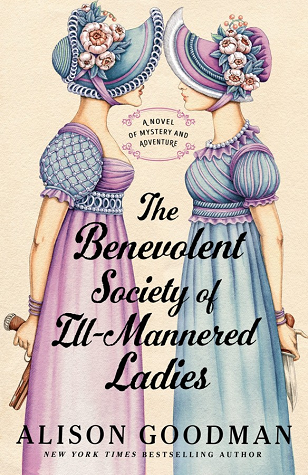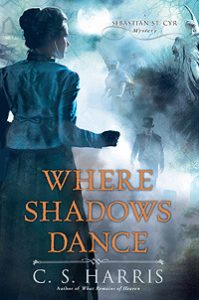 The Benevolent Society of Ill-Mannered Ladies (The Ill-Mannered Ladies, #1) by Alison Goodman
The Benevolent Society of Ill-Mannered Ladies (The Ill-Mannered Ladies, #1) by Alison Goodman Format: eARC
Source: supplied by publisher via Edelweiss
Formats available: hardcover, large print, paperback, ebook, audiobook
Genres: historical fiction, historical mystery
Series: Ill-Mannered Ladies #1
Pages: 464
Published by Berkley on May 30, 2023
Purchasing Info: Author's Website, Publisher's Website, Amazon, Barnes & Noble, Kobo, Bookshop.org, Better World Books
Goodreads
A high society amateur detective at the heart of Regency London uses her wits and invisibility as an 'old maid' to protect other women in a new and fiercely feminist historical mystery series from New York Times bestselling author Alison Goodman.
Lady Augusta Colebrook, "Gus," is determinedly unmarried, bored by society life, and tired of being dismissed at the age of forty-two. She and her twin sister, Julia, who is grieving her dead betrothed, need a distraction. One soon presents itself: to rescue their friend's goddaughter, Caroline, from her violent husband.
The sisters set out to Caroline's country estate with a plan, but their carriage is accosted by a highwayman. In the scuffle, Gus accidentally shoots and injures the ruffian, only to discover he is Lord Evan Belford, an acquaintance from their past who was charged with murder and exiled to Australia twenty years ago. What follows is a high adventure full of danger, clever improvisation, heart-racing near misses, and a little help from a revived and rather charming Lord Evan.
Back in London, Gus can't stop thinking about her unlikely (not to mention handsome) comrade-in-arms. She is convinced Lord Evan was falsely accused of murder, and she is going to prove it. She persuades Julia to join her in a quest to help Lord Evan, and others in need—society be damned! And so begins the beguiling secret life and adventures of the Colebrook twins.
A rollicking and joyous adventure, with a beautiful love story at its heart, about two rebellious sisters forging their own path in Regency London
My Review:
Lady Augusta Colebrook is an ape-leader. She’s a 42 year old spinster with no prospects of marriage whatsoever – and she’s content in that state, living with her twin sister Julia in rather well-upholstered circumstances. Lady Augusta and Julia may still be under the control of the younger brother who inherited the title, but his control is limited to general opprobrium and ownership of the house they live in as they have independent means of their own.
What makes Lady Augusta (generally called Gus by her friends and intimates) an ape-leader? The term is from an old English adage which said that a spinster’s punishment after death, for failing to procreate, would be to lead apes in hell. Technically both Gus and Julia are ape-leaders, but Gus’ personality tends toward leading considerably more than Julia’s does or ever will.
Julia is a peacemaker who thinks the best of everyone. Gus is the person in whose wake Julia is generally trying to make peace after Gus has refused to kowtow to the behavioral expectations due to her gender.
The sisters should be content to sit on the sidelines of Regency society and mind their own behavior while observing the misbehavior (amorous and otherwise) of the younger and livelier members of the ton.
But there’s life in both of these “old girls” yet, and Gus at least is determined to make sure that both of them experience that life to the fullest – for whatever time her sister might have left. Which leads them to the kind of dangerous derring-do that neither of them ever expected.
The kind of adventure in the kinds of places that may very well get them killed – even as it opens their eyes to the kinds of things that no well-bred, well-behaved woman is expected to see or know.
But once they’ve seen, once they know, they can’t unsee. And they can’t help but try to fix what they can with as much benevolence as possible.
Escape Rating B+: “Well behaved women seldom make history” or so goes the famous quote by Laurel Thatcher Ulrich, which may be a quote from 1976 rather than the Colebrook sisters Regency – but very much still applies.
It’s also the reason I picked this book up.
The cover, and the blurb, both lead readers to the impression that this book is going to be on the light and frothy side, but that is far from the case. Rather than being a look at the frivolities and minor disgraces in the life of the ton, as so many Regency romances are, The Benevolent Society of Ill-Mannered Ladies shines its light in very dark places, in a way that is not dissimilar to C.S. Harris’ Sebastian St. Cyr series.
 Both the Colebrook sisters and St. Cyr are conducting their investigations during the Regency period, in this book specifically 1812 – which is also the year in which books 4 through 8 of the St. Cyr series (Where Serpents Sleep, What Remains of Heaven, Where Shadows Dance, When Maidens Mourn, What Darkness Brings) take place. Both series expose the slimy underbelly of the glittering Regency, but they do it from different perspectives.
Both the Colebrook sisters and St. Cyr are conducting their investigations during the Regency period, in this book specifically 1812 – which is also the year in which books 4 through 8 of the St. Cyr series (Where Serpents Sleep, What Remains of Heaven, Where Shadows Dance, When Maidens Mourn, What Darkness Brings) take place. Both series expose the slimy underbelly of the glittering Regency, but they do it from different perspectives.
St. Cyr, as a member of the aristocracy, operates within the halls of power, while the Colebrook sisters, as disregarded females on the outskirts of the ton, expose the dangers that specifically affect women in that society merely for living while female. In a way, it’s as though Sebastian’s wife Hero, a social reformer in her own right, was the focal point of his series.
(This is all a very large hint that if you enjoy the one series you’ll probably enjoy the other, as they are shining their lights into the dark places of the same historical period. Just not the same dark places.)
What makes the dark places that the Colebrook sisters so chilling is that the places their so-called ill-behavior takes them were all much too real. And it’s much too easy for a reader to imagine themselves in those circumstances. Women really were not just their husband’s property in this era, but his to seemingly dispose of as he pleased, even into an early grave whether indirectly by way of an insane asylum or by an outright murder which was entirely too easy to cover up in a world where a man’s word was law, his wife was chattel and forensic science hadn’t even reached infancy yet.
It’s no wonder that Gus has no desire to marry – she’s too intelligent not to be aware that for a woman with both independent means and an independent streak a mile wide, the costs for her could be deadly.
The conditions that Gus and Julia investigate in the three stories that make up this book are dark, gruesome and inescapably real, to the point where this book needs a whole lot more trigger warnings than that blurb would lead one to believe.
Whether or not a reader will stick through those dark places is going to depend a lot on how one feels about Gus and Julia, because they, especially Gus, are the ones leading us through multiple valleys of the shadow of death, and if they aren’t people you’re willing to follow, then it doesn’t work.
I felt for Gus, and liked her intelligent observations of the conditions she was supposed to live under and decided to refuse from her position of relative privilege. I’m not totally sure she successfully walked that fine line between giving a historical-set heroine enough agency to do the things we need her to do to be the protagonist without making her more of a creature of our time than hers. Julia does feel like a woman of her times, which is why she drove me a bit crazy as a character as I couldn’t get into her head at all.
Your reading mileage may vary when it comes to Gus and Julia, but there seems to be no debate on the personality of their brother Duffy. Duffy is used to demonstrate just how circumscribed their lives are supposed to be by the lights of their society. He’s also a total arsehat, a person whose head is so far up their arse that they are wearing it for a hat. And in Duffy’s case, only the British spelling will do. He’s the character we all love to hate. If this were the froth that the cover picture leads you to believe, he’d be both the villain AND the comic relief.
Instead he’s a symbol of everything that’s wrong and just why Gus needs to fight back so damn much and so damn hard.
While there is a bit of a romance hinted at, this is far, far, far from being what is usually meant by a Regency romance – and it’s a much more interesting book for it, but perhaps not for the faint of heart.
